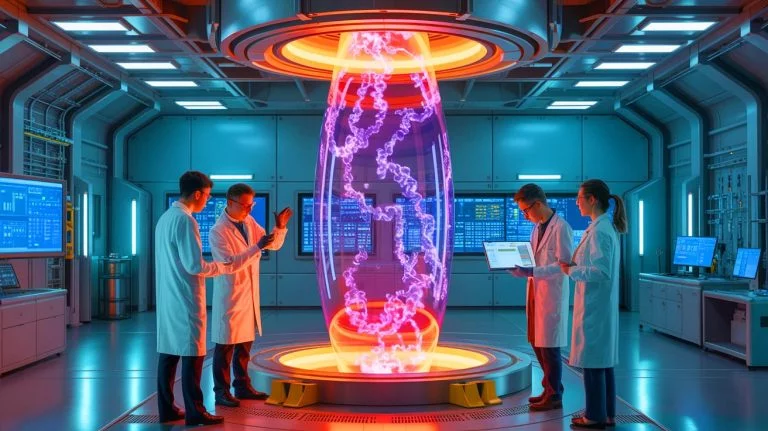| IN A NUTSHELL |
|
China’s new CHSN01 ‘super steel’ represents a significant leap in materials science, poised to revolutionize the future of fusion energy. This innovative alloy, designed to withstand extreme conditions, is set to play a crucial role in the development of smaller and more efficient tokamaks. By enabling reactors to operate under higher magnetic fields and endure extensive cycling, CHSN01 could dramatically reduce the size and cost of fusion reactors. This advancement not only holds promise for China’s ambitious energy goals but also sets a new standard for the global fusion community.
The Revolutionary Composition of CHSN01
The CHSN01 alloy stands out due to its unique composition, which enables it to function almost elastically at cryogenic temperatures. Engineers began with Nitronic-50, a nitrogen-strengthened austenitic steel, and meticulously adjusted its components. They reduced carbon content to below 0.01 percent, preventing brittle carbides from forming over time.
Additionally, the nitrogen content was elevated to about 0.30 percent, accompanied by increased nickel levels. This combination maintains the metal in a tough, ductile austenite phase even at temperatures as low as -452°F. A trace of vanadium further strengthens the alloy by forming vanadium-nitride particles, enhancing strength without compromising toughness.
By imposing strict cleanliness limits on elements like oxygen, phosphorus, and sulfur, the researchers ensured no impurities could initiate cracks under pressure. These precise chemical modifications result in an alloy capable of withstanding 1.5 gigapascals of stress while stretching over 30 percent before breaking, making it significantly stronger and more crack-resistant than previous materials.
The Importance of Stronger Superconducting Jackets
In the world of tokamaks, superconducting magnets are essential, acting as the pulsating heart of the device. When current flows through these magnets, significant electromagnetic forces are generated. Engineers typically counter these forces by either reinforcing the structure with additional bulk or using a robust jacket to contain the conductor.
China’s decision to utilize CHSN01 highlights their preference for the latter approach. This material allows the jackets to sustain initial flaws significantly above the nondestructive testing detection limits, ensuring longevity and reliability. Consequently, manufacturers can reduce the weight, cost, and time associated with producing these components.
Moreover, stronger jackets enable the use of higher magnetic fields, potentially increasing the confining pressure on plasma by a factor of four. This advancement allows for the design of more compact reactors, reducing construction costs and facilitating the possibility of modular fusion units, akin to modular fission reactors.
Durability and Fatigue Resistance
Beyond sheer strength, CHSN01 boasts impressive durability, crucial for the long-term operation of fusion reactors. Fusion magnets undergo frequent pulsing, and any material used must endure this cycle repeatedly. Researchers conducted extensive fatigue-crack-growth rate testing at cryogenic temperatures to ensure CHSN01’s durability.
The results, verified with a high degree of confidence, indicate that the alloy can initiate with a flaw area of up to 1 mm² and still perform reliably throughout its expected lifespan. This robust performance provides inspectors with definitive criteria for nondestructive testing, an improvement over previous alloys.
The ability to predict the material’s life under real-world conditions ensures that the fusion reactors using CHSN01 can operate efficiently, with minimal risk of failure due to material fatigue. This reliability is a significant step forward in achieving sustainable fusion energy.
Industrial Applications Beyond Fusion
The potential of CHSN01 extends well beyond its application in fusion reactors. Zhao Zhongxian, a pioneer in cryogenics, foresees its impact across various high-stress, low-temperature applications. MRI machines, particle accelerators, maglev trains, and quantum-computing refrigeration systems all face challenges similar to those in fusion reactors.
Incorporating a stronger and tougher steel like CHSN01 could lead to smaller magnet footprints, reduced maintenance intervals, and improved overall performance in these technologies. The alloy’s versatility and strength make it an attractive option for industries seeking to optimize their systems for efficiency and longevity.
By offering a material solution that addresses both strength and durability, CHSN01 could become a cornerstone in the advancement of multiple cutting-edge technologies, paving the way for innovations beyond the realm of fusion energy.
China’s development of CHSN01 represents a quiet yet significant advance in materials science. While fusion breakthroughs often capture attention with bold reactor designs or record-setting plasma shots, the true success of these technologies hinges on the materials that support them. By achieving a balance between high strength and toughness, Chinese researchers have set a new benchmark for fusion materials. As the global community observes China’s progress, one question remains: how will other nations respond, and what innovations will this breakthrough inspire in the quest for sustainable energy solutions?
Did you like it? 4.5/5 (24)






Wow, -450°F? That’s colder than my ex’s heart! ❄️
How does CHSN01 compare to other super alloys?
Can’t wait to see how this impacts the cost of MRI machines!
Is this steel already being used in any existing projects?
What are the environmental implications of producing CHSN01?
CHSN01 sounds like a game-changer for fusion energy.
Thank you for such an informative article, very enlightening!
I wonder if this can be used in space exploration technology. 🚀